Just a remix for a wonderful duo (Carlomac and Shi):
Thanks to Carlomac and to Shi for their wonderful track, thanks to Richard and to the whole Kaiser family for Wikiloops, and thanks to you for listening 🙂

Music. Photography. Thoughts.
Got myself some “Reference-grade headphones for analytical listening sessions”, as it says on the box:
And, a bit further up on the same box, the product name:
And the Sennheiser HD 560S, currently available for 149€ instead of 199, are just wow. Watch a review from a Youtuber who calls himself “DMS” who is also cited on the product page:
So yes, for that price they are without any real competition if you need headphones which you can trust, without having to eq or “correct” them, which is what I did with my Sennheiser HD 598SE during the last years. First listens of today were:
and finally one from our “mix master” at wikiloops, Monsieur OliVBee:
I also tried to listen with some equalizer settings and frequency curves made for and of these headphones from a reddit user named “oratory1990”, find his list and explanations/howtos and free programs here. With these, Oliv’s track #10082 sounded just like with my corrected headphones before, but the interesting thing was: I liked the sparkle on these cymbals even more *without* that correction – these cans are great right out of the proverbial box!
So well done, Sennheiser. You have some headphones there which are like the famous HD600 in their neutrality, with an even more pronounced bass, and very very detailed. Bravo! I can only recommend to try these.
This is no advertising – I paid them with my own money, and my trusty old HD 598SE with new earpads will find a new home at some relative’s place.
As always, thanks for reading (and maybe listening). And look up oratory1990, maybe you’ll find some correction curves/settings for your own headphones.
P.S., from later in the evening:
I have listened a bit more, and tried both pulseeffects on Debian (with pulseaudio and jack) and easyeffects on Arch (with pipewire), the LSP parametric eq was the same. And so was the sound, with oratory1990’s recommended eq settings it’s pretty much the same as my Sennheiser 598SE, corrected with Sonarworks (99$). But the difference with the 560S is pretty minimal, so you don’t have to eq it. But this is just a cheap (free) method of getting a sound reproduction which is very nice, and close to reality. So – I can recommend both the headphones *and* the eq methods and curves. Nice 🙂

Again, thanks for reading. And good night.
Can’t make this public on YT due to negotiations with the BBC – but I can still use it on my private blog as they confirmed…
…so thanks go out to Dr.Whom for his awesome composition, to Shi for the lyrics and for her sweet vocals, and to the BBC Cymru for providing us with such great shows.
The video mainly shows my desktop with the free and open source Ardour DAW (digital audio workstation) running, but also provides some images and videos by the BBC:
Original audio is on Wikiloops. Enjoy, and thanks for reading, and for listening and viewing.
(Another four and a half billion years, as “Clara” says here, and I will still love this song. “Love is eternal”, as Shi sings…) 🙂 <3
Zoom has a new multieffects pedal just for us bass players:
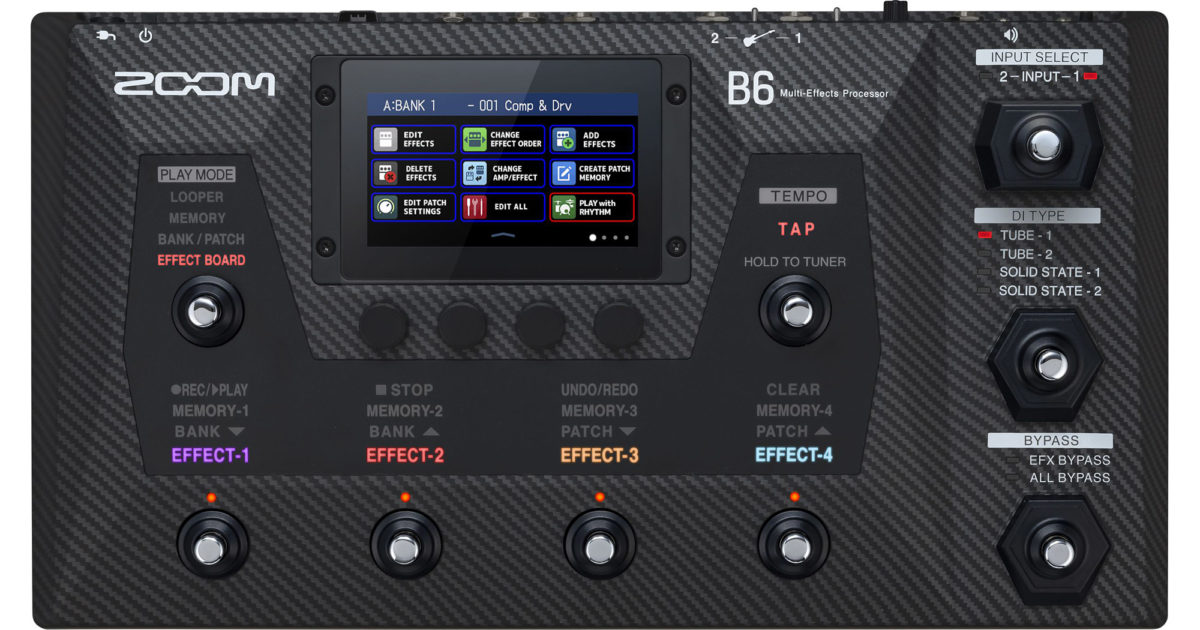
The interesting parts are the nice sounds, the versatility (almost like a Line6), but especially the two inputs on which you can switch the impedance from 1MOhm to 10MOhm which is good for piezo pickups like the ones on double basses. And additional to all the amp and cabinet simulations it also has four simulated DI outputs, two of them tube, the other two solid state.
Found it via No Treble where they also embed a video…
Paul is the founder and chief developer of Ardour and Jack, and hearing him is always interesting. So here’s a podcast interview with him which I’ve found via the Linuxmusicians’ forum. Enjoy.
In regards of space I’m a bit restricted, and so my thoughts about computers and cases to put them into lead me to Mini ITX, and to a case which was introduced last year and which immediately became one of the favourites in that size and price class, the CoolerMaster NR200P. Here’s Leo from Kitguru reviewing it:
You can also read their/his written review here in case you want to know more.
As you could see in the review video, my current drives – one 2,5″ SSD and one 3,5″ hard disk with 4TB – the same Leo was showing – both fit nicely. Plus modern mainboards all have space for one or two M.2 SSD drives which are even faster anyway, and the case could even take two more 2,5″ SATA SSDs behind the front plate – that’s 6 drives overall, surely more than enough storage options.
Of course one should also try to save some space with choosing components wisely, so as a power supply I’d take Corsair’s smaller SFX ones, the ‘Platinum’ specced ones have a set of nicer braided cables compared to the ‘Gold’ rated ones. Without ever planning to add a graphics card, a 450W model would be more than enough, if you want to keep the possibility to add a medium- or high powered graphics card later on, there are also models with 600 or with 750W available. Remember, the high powered system Leo was building there drew some 500 Watts from the wall socket when stressing it out, both CPU and GPU alike. For me, that would rarely to almost never happen… so what about cooling?
I’d go with air cooling with a Noctua L12S low profile top blower cooler. I’d never overclock a system, so that should be just fine for a CPU with a TDP of around 65W like the AMD Ryzen 5 5600G (6 Core / 12 Thread), the Ryzen 7 5700G (8 Core / 16 Thread) or a comparable Intel Core i5-10400 (not the “K” versions which take lots more power). Learn more about such coolers from Machines & More:
In case you also take low profile (or JEDEC-compatible) RAM which isn’t higher than 31,25mm, you could even let the cooler’s fan *under* the heat sink if you so desire, although these tests showed that it’s performing a bit better if you have the fan on top of the heatsink.
So for RAM a kit of 2x8GB or 2x16GB DDR4-3200 from Corsair (“Vengeance”) would be cool and wouldn’t restrict your mounting options.
For the main board, I’d go with Asus, but Gigabyte is also a good option and maybe a bit cheaper. Even MSI has a nice board, for AMD CPUs I’d take one with a B550 chipset, for 11th gen Intel chips a Z590 one.
All of the mentioned CPUs have graphics built right in, so you won’t have to overpay for graphics cards (only gamers would want these anyway, you can cut movies or “develop” photos without a dedicated graphics card just fine).
That would be cool machines, and maybe I’ll build one of these for a relative soon.
Oh, and a propos benchmarking: my own current system which is quite old already, and still has a 4th gen Intel Core i5 was behaving quite nicely when I stressed out its CPU with the Blender render “classroom” test:

As you can see, CPU average temperature was 41°C, max was 52°C, and the system was drawing about 72 Watts from the wall socket while doing this. Of course this took quite a while:
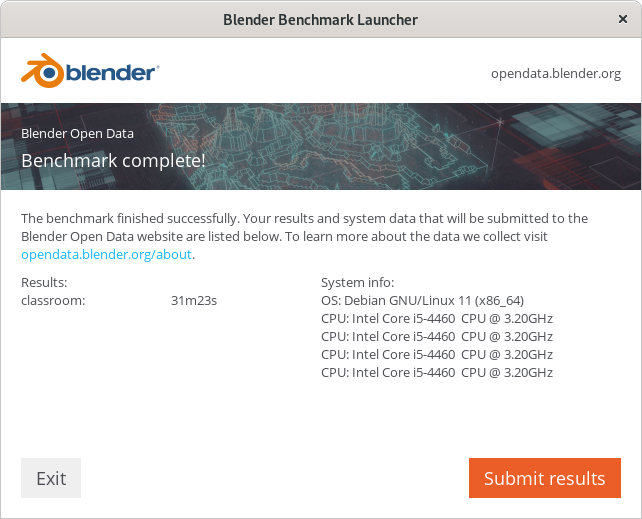
Over 31 minutes is slow, a more modern machine and chips like the ones mentioned above should do the same in about 8-10 minutes. And while they might draw a bit more power, they’d still do it in about a third to a quarter of the time, which makes them much more efficient in case you need that power…
As always, thanks for reading.
Just found this awesome series from Robin Vincent about how to build an audio PC. It’s a bit over 2.5 years old, so when he’s talking about chipsets etc. it’s not that current anymore, but the principle is just right – and because I think that some of my friends over at Wikiloops would possibly be thankful for such explanations, here it is:
Of course I would install Linux instead – or Windows *and* Linux – or Windows and *two* instances of Linux, which is what I did with my own machine. But that’s not part of what he’s talking about here, and I found his series really interesting. So thanks to Robin, and I hope that some of you who read this might find it useful as well.
As always, thanks for reading, viewing, and/or listening.
The more I’m using my new Debian 11 “Bullseye”, the more I like it. The first – and big – change to something better is that thanks to Geoffrey Bennett, a friendly musician and developer there’s now a Linux driver for the Focusrite Scarlett 2nd and 3rd generation interfaces in the kernel versions 5.x – see his latest thread on Linuxmusicians about it. He’s even developing graphical tools to manage these audio interfaces, but hasn’t released anything public yet. Still they work great, and I can now switch inputs from line to instrument, or assign a -10dB pad with a simple mouse click for instance in qasmixer, which shows my interface like this:
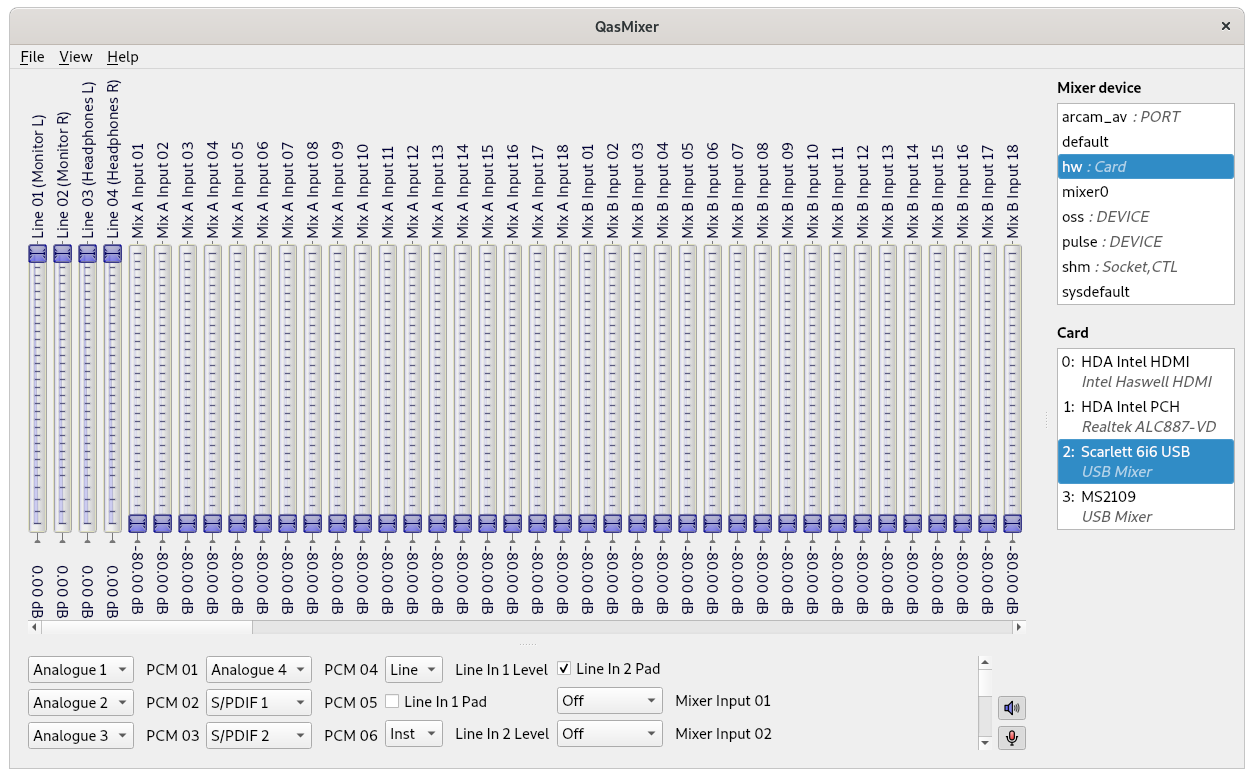
This is cool because now you won’t need any Windows- or Mac-only software just to change settings on your interface (only the smallest Focusrite interfaces have physical switches, and none comes with software for Linux).
I have also set up a new LADISH studio for the Sonarworks headphone correction in Cadence and Claudia, and Cadence bridges all of Alsa, Pulseaudio, and Jack nicely so that it all works together. The cabling for my self-built “systemwide” setup for Linux in Carla looks like this:
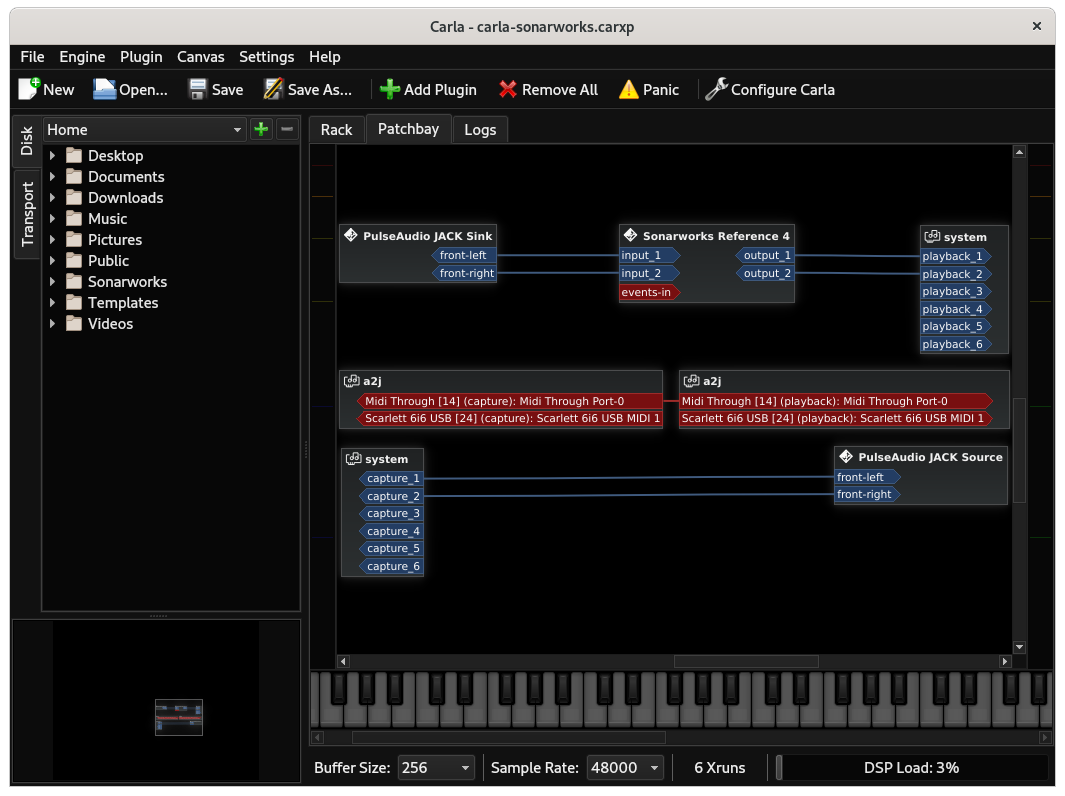
Of course, I also had to select the right inputs and outputs for Pulseaudio in their pavucontrol, which looks like this:
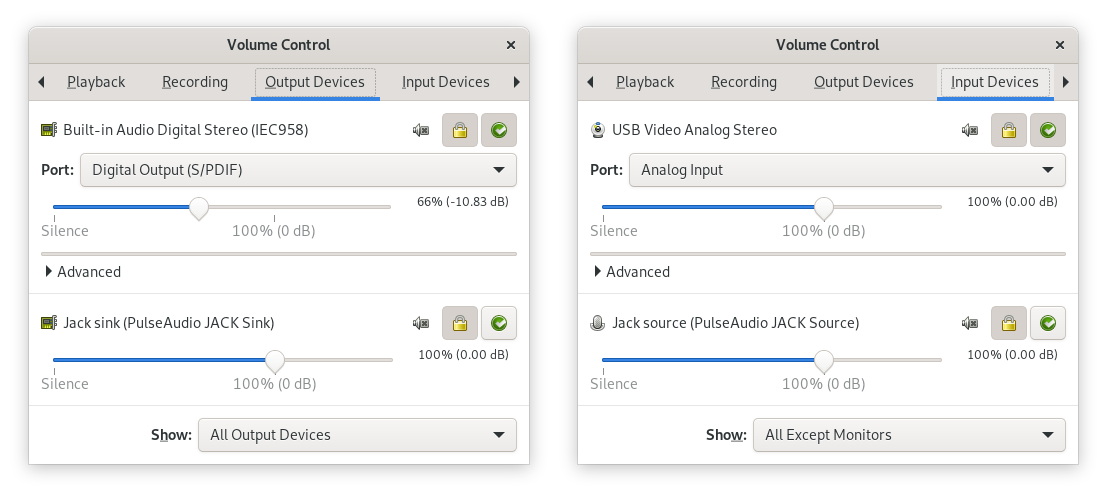
And these settings also allow third party applications like SongRec to check if a song might be a cover of others – and if yes, it shows something like this:
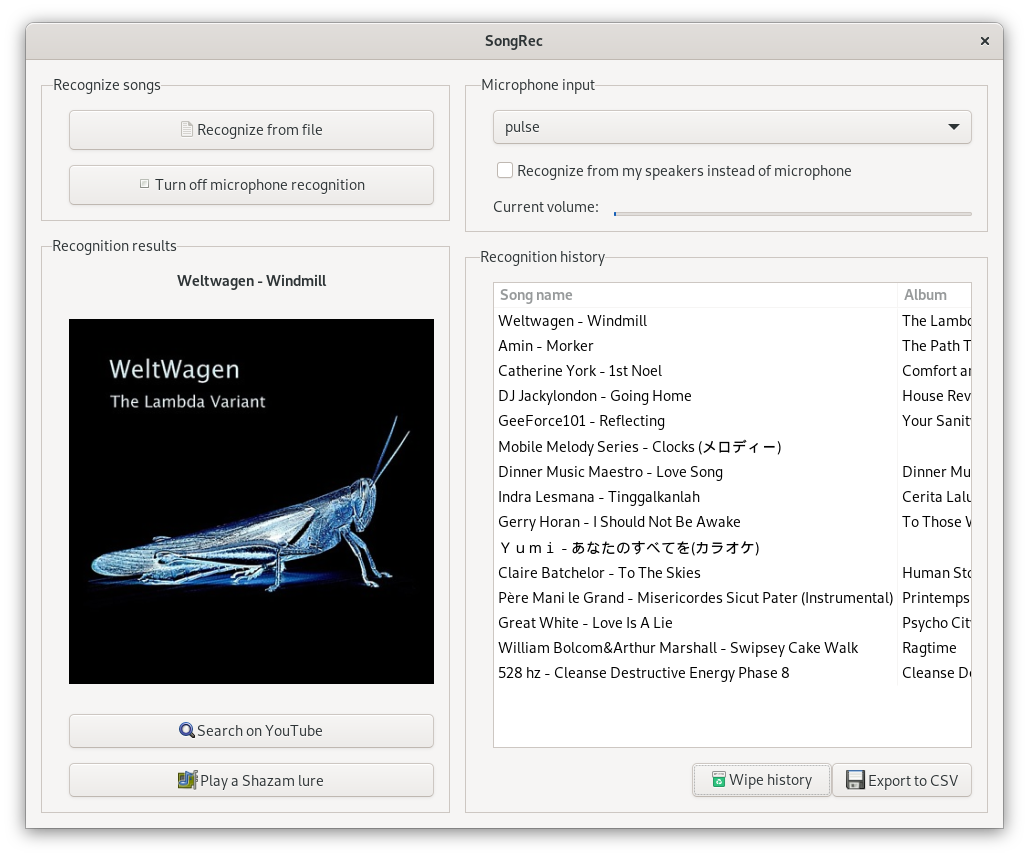
All of this is very complex because the Linux sound systems are so many, from Alsa over Jack to Pulse, and so on. But it all works nicely now, better than ever I’d say.
On Arch Linux I have Pipewire which tries to replace all of the sound servers mentioned above, and that also works – tho I haven’t looked that deep into it, and it’s also not quite ready yet. But from what I have seen and heard so far, that one is also perfectly usable already, so no matter which system is up and running (except Windows), I could make some music.
Good times. I’m happy that my transition to newer operating systems worked so well. And so today I also wiped all partitions from my old 250GB system drive which will go and find a new home in my brother’s PC as soon as he has time to deal with that. I already made a Ventoy-based USB boot stick with these same systems on it (plus some others which he hasn’t seen yet) for him.
Ok, enough for today. And thanks for reading, as always.
Before I forget it – every newly published album becomes ‘album of the day’ on Wikiloops, and so did my latest one today:

Go and listen to it if you like. And thanks for reading, and for listening, or even downloading. Thanks to Richard, and to Wikiloops and its musicians and supporters for making this possible.
Just published a new album on Wikiloops, and here’s its front cover from Flickr:
Photo: “Photo of Woman Sitting on Chair”, Jorge Fakhouri Filho
https://www.pexels.com/photo/photo-of-woman-sitting-on-chair-2530717/
As always, thanks to my friends on Wikiloops, and to Richard & family. Thanks to you for listening, downloading, and so on… hope you’ll like it 🙂